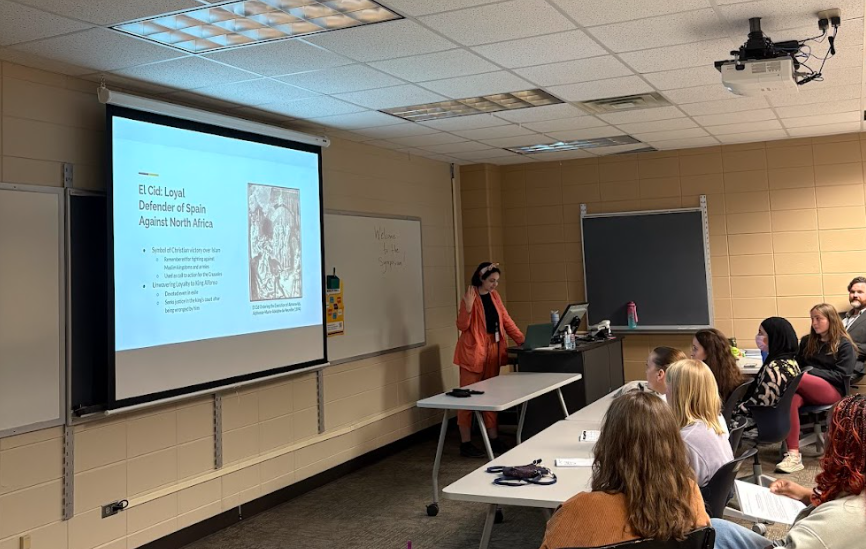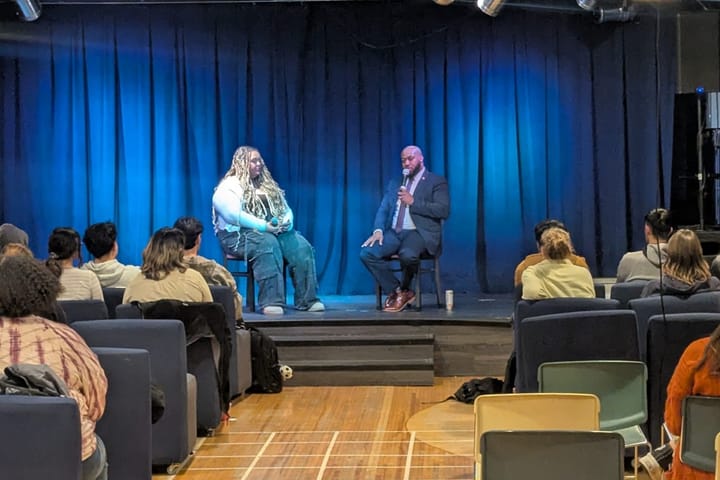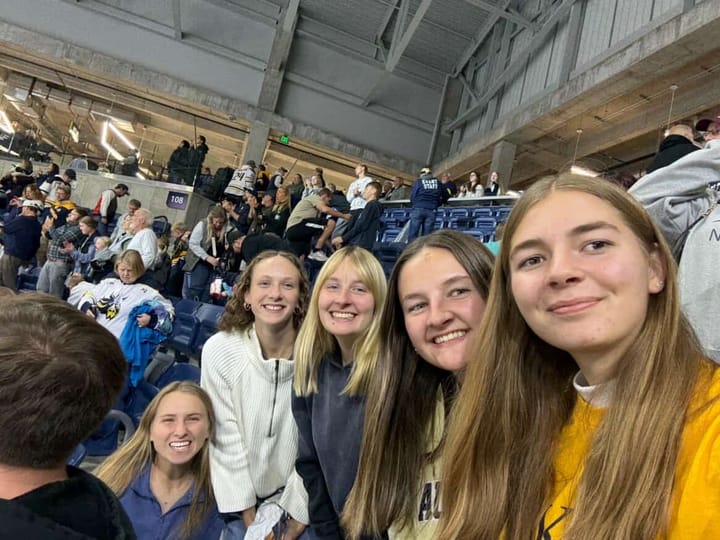Record turnout at symposium

The Arthur Olsen Student Research Symposium hosted a record number of student researchers on April 26. With 55 oral presentations and 56 poster presentations, the Fryxell Humanities Center buzzed with activity throughout the day.
“There’s about 30 more [presenters], which is kind of a big percentage — not a math guy, but it’s a big percentage,” Emily Roehl, chair of the symposium committee, said.
Roehl said the symposium was originally held in the Fryxell Humanities Center, and that as the symposium grew, it made sense for the newly built Froiland Science Complex to host.
“ It’s very likely it will be in the FSC in the future because it’s a really nice space,” Roehl said. “But this year I was like, ‘Hmm, it’s kind of nice that I’m the chair, and I get to bring it back to my building for a year.’”
From 11:35 a.m. until 3:10 p.m., people filled classrooms and atrium to hear students share their research covering various disciplines.
Senior Sammie Kross, an anthropology and environmental studies major, presented her research titled “So That All May Kayak: Inclusive Kayaking & Community Engagement.”
Kross said her internship at the Outdoor Campus as a volunteer coordinator inspired her to look at how kayaking can be more inclusive and accessible.
“Getting in and out [of a kayak],” Kross said.“That’s a doozy we’ll get to later.”
Kross showed images of equipment that can assist people with entering a kayak, but all of the options require money. Kross said that the Outdoor Campus will fund two adaptable kayaks for people to use that include mechanisms to help with paddling.
“It’s a chance to give to folks, if they want to try kayaking, for free,” Kross said.
Poster presentations occurred between 12:45 and 2 p.m. throughout the atrium and concourse. Hundreds of people stood shoulder to shoulder, listening to presenters discuss topics ranging from vaccination hesitancy to spatial analysis of the Mikkelsen Library.
Four students from psychology professor Shannon Proksch’s Directed Research class presented two of the 56 posters in the atrium.
Senior Zach Nickels and junior Sydney Hansen presented their poster titled “Neurophysiological time course of timbre-included music-like perception in report and non-report conditions: A replication and extension of Santoyo et al (2023).” Junior Aiden Heisinger and senior Will Davis presented “Emperor’s New Groove: Sensory Features Underlying the Perception of Musical Groove.” Both posters related to the same research.
Nickels, a biology, psychology and neuroscience major, said this research extended a previous study. The original researchers had proposed that alpha suppression would occur when listening to changes in timbre but didn’t observe this effect.
“ The participants just sit there and passively listen to the music,” Nickels said. “So we’re hoping to see that alpha suppression with that non-primary auditory cortex (NPAC).”
“ It’s kind of a complicated topic to explain in layman’s terms, but we’re really just exploring how the brain processes music,” Heisinger said.
Following the poster presentations, 26 oral presentations continued into the afternoon. Junior Jorgen Hansen, a history and government major, gave a presentation, titled “Indian Adoption: Care or Culture?,” that challenged the section of the Indian Welfare Act that requires adoption agencies to look for a Native family first for Native kids before they look elsewhere.
“ I’m basically being provocative and saying we should challenge this [Welfare Act] on the basis of we’re putting cultural considerations over well-being of the child,” Hansen said.
Hansen said he chose this research topic because his great-grandpa worked with government social services in the 1970s and 80s around Watertown, South Dakota.
Hansen’s research prompted his audience to ponder transracial adoptions and varying definitions of what constitutes a “good home.”
“We need to address our biases a little bit, and it’s important to consider them,” Hansen said in response to sociology professor William Swart’s question about how a “good home” varies across cultures.
Junior Amina Koch, a junior English; Spanish; and languages, literatures and cultures major, closed the symposium with her second presentation of the day. Her first focused on the similarities and differences between Ophelia’s and King Hamlet’s deaths in Hamlet.
Her second presentation, entitled “Men, Myths, and Monsters: Exploring the Transformation of Real People into Nationalistic Symbols through Cantar de Mio Cid and Dracula,” compared how two historical figures were fictionalized for different purposes.
Koch said she made this connection with her previous work on Dracula with English professor Darcie Rives-East.
“ Dracula was just in my mind, and so I was like, hold on: We have these two different medieval warlords, and they’re used for these very different means,” Koch said. “So I just found that contrast to be really interesting.”
Speaking to a full classroom, Koch guided her audience through an analysis of how these historical figures became literary symbols.
Koch concluded her presentation by reminding the audience that it is important to look beyond current narratives and develop a new understanding of what we read.
“People don’t necessarily see the value in really understanding the world around us and the complexities of these stories that we tell,” Koch said. “So I was really drawn into taking a look at that examination, that process of these stories, and calling attention to a lot of the history and the dynamics that flow behind them.”
As the event concluded, students, faculty and other supporters exited while a few professors and committee members remained chatting in the concourse.
Roehl said that the symposium committee expect the event to continue to grow in the future as class sizes also continue to increase.
“ Students are increasingly doing research with their professors or doing capstone projects or doing papers that they’re really proud of, that they want to present, want to build their resume with,” Roehl said. “So I think [the symposium] will keep getting bigger, and we’re going to have to keep finding space to fit it all.”



